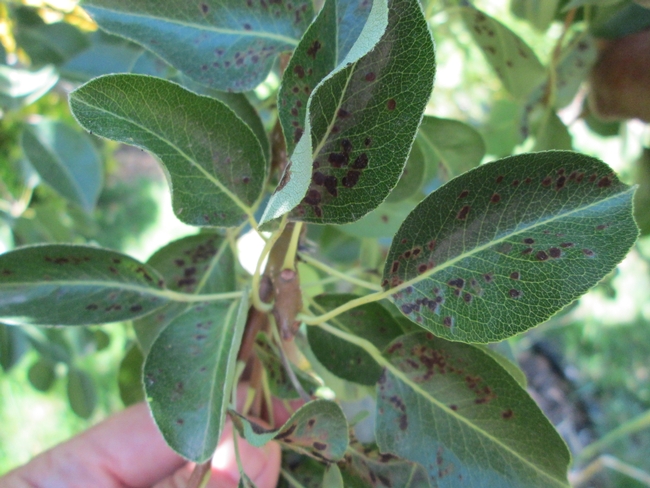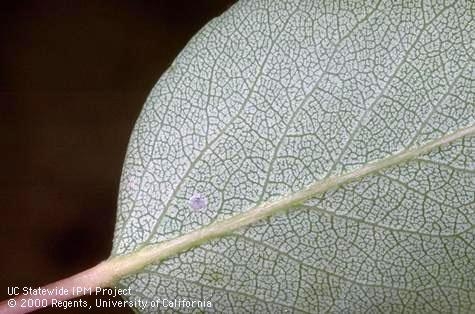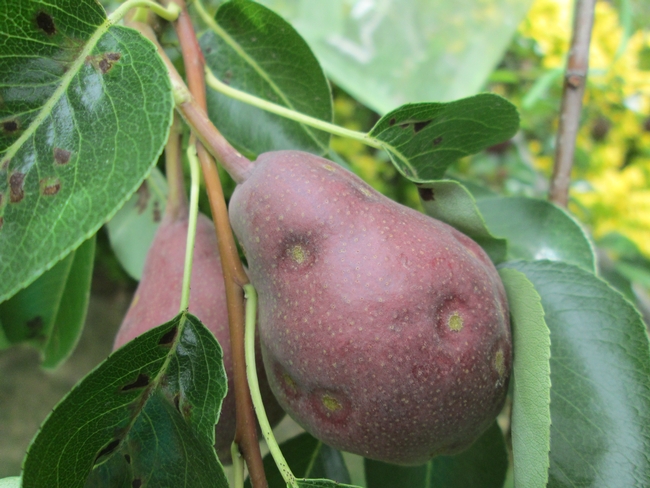- Author: Alison Collin
As winter turned into spring and the 'Bartlett' pear tree flowered and leafed out, I celebrated my great gardening success. In fact I was jubilant because it looked as though I had finally won the battle against fire blight! For the first time in four years there were none of the telltale signs of this disease - no blackened leaves or "shepherd's crook" stem tips. For a time it looked as though I would never win, but careful pruning and rigorous attention to hygiene had finally paid off.
My only problem now was how to restore the tree into something that would justify my title of Master Gardener.
The tree had put on a lot of growth last year, and in typical pear fashion, all the new growth was fastigiate, shooting skywards with nothing but weakly attached, narrow crotch angles around the trunk and vertical stems emanating further out from the old, lateral branches. It looked a complete mess, and in spite of studying this problem over several months I had no idea how to tackle it. I became paralyzed with indecision and did nothing.
This spring, the tree was covered in flowers and set a good crop, which for once were not damaged with frost rings, and there was still no sign of fire blight. However, as I thinned the fruits I noticed that some of them were distorted, and a few of the leaves were developing blisters and brown spots suggesting that the tree had a new problem: pear blister mites.

By this time of year there was no hope of getting any control by spraying, so my next chance will be after harvest, in October or November when the mites travel away from the leaves and take up residence in the developing buds for the winter where they are again protected from the effects of sprays.
There is a small window of opportunity during this migration, and I will check for mite activity by sampling buds at various intervals and looking at them under a strong magnifying lens in order to monitor mite activity, and then spray to control. In order to comply with organic growing principles the chief methods of control available are either oil sprays or sulfur sprays. Some pears such as comice or Anjou are damaged by sulphur which cuts down on options for those varieties.
I think that I would rather deal with fire blight!
Maybe next I will be luckier.
For more information:
- https://ipm.ucanr.edu/agriculture/pear/pearleaf-blister-mite/
- https://ipm.ucanr.edu/agriculture/pear/dormant-to-delayed-dormant-sampling/
- Author: Dustin Blakey
If you open up a pest management guide for apple or pears—those books really exist, by the way—the first insect listed is always the dreaded codling moth. These are the creatures responsible for turning an apparent bountiful harvest of fruit into a brown, wormy mess in late summer. Codling moth is the main insect pest that attacks apples and pears in our region.
After overwintering as larvae, the moths emerge in spring, mate and then proceed to lay eggs on the fruit. These eggs hatch into tiny larvae that eat their way into your fruit, ruining it in the process. Fully grown larvae fall out of the fruit, pupate into adult moths (usually on the ground), and the process repeats. In the Owens Valley, there are usually two generations that we worry about controlling. Their development is mostly driven by temperature.
The first generation of adults usually emerges in April, and egg laying follows in a few weeks. The exact timing varies each year and by location, north or south, in the valley. The second generation lays its eggs over an longer period, but it is usually in July. Most of the complaints of ruined fruit by gardeners are from this second generation.

Because there are at least two generations to be concerned with, it is essential to get control during the first generation so that you have fewer moths to fight later on.
While it's possible to achieve control by just using continual sprays through the season with insecticides, this isn't usually how we deal with this pest since that's wasteful and carries risks. Codling moth is usually controlled through a combination of means.
Commercial codling moth control is a complex topic. There is a great body of peer-reviewed literature on the subject. In the home landscape it really isn't possible to implement a full, successful control program. UC has a simpler set of guidelines for landscapes and gardens here.
The approach I would recommend to is to watch your fruit closely. Ideally you should learn what a codling moth egg looks like and learn to identify it. If you want to control with sprays, egg laying is the only feasible time to apply an insecticide, Organic or otherwise.


Codling moth eggs are tiny and hard to see. They look like tiny translucent pancakes about as big around as a pencil's lead. These are usually laid near the blossom end of the fruit. I find them easier to see in the morning or late afternoon when the sun is low in the sky. They are slightly reflective and having sunlight reflecting on them is a big help. Check those fruits you can reach easily from the ground for the eggs by turning the fruit and looking around the blossom end. The third week in April is a good time to start looking in our area. Continue this through mid-May. Remember that Bishop is about 1 week behind Lone Pine in timing. Check for eggs again in late June through July. Egg laying is your best shot for applying controls.
If your eyes aren't good, you'll have a hard time knowing when to time sprays by finding eggs, but there are other options. A favorite home control technique of mine is to remove all fruit of the first generation that has a worm. This alone can go a long way in getting control, especially if you're not surrounded by neighbors with wormy fruit.
If you really want to have clean fruit, in June you can bag fruit to protect them from insect attack. Garden supply companies sell bags for this purpose, but you can improvise as well. Have bags on fruit before egg laying commences. Since we have wind issues, you'll need a way to secure the bags onto the fruit. Bagging is a lot of work! Anytime you see fallen or damaged fruit on the tree, you should remove it immediately whether you bag or not.
Unless you are committed to bagging fruit, most homeowners who demand high levels of control will need to spray some product. These vary from biological organisms that kill the target pest as well as naturally or synthetically derived insecticides. Because these products and recommendations change so often, I'll direct you here for current recommendations. (See bottom of that page.)
Codling moth control is definitely a challenge, but you can expect reasonable control with a little effort on your part. Even if you lose some crop each year, you should still have enough to make growing apples and pears worth your while.
- Author: Dustin Blakey

All over our region we are receiving reports of fire blight occurring on fruit trees. This bacterial disease primarily infects pears, apples, quince and pyracanthas in our area. While there are a few other species out there that can be affected, it is unusual to see them attacked. Peaches, plums and cherries are not affected by this disease.
Fire blight is a bacterial disease. It usually gets its start during the bloom period of susceptible hosts. Early on it looks like wilted shoots and flower buds. Most gardeners do not notice the disease until it has turned entire shoots black. This burnt appearance happens suddenly which gives the disease its name.
By the time you see burnt shoots, it is too late to do anything to stop it. You're too late now. This summer, plan on pruning out all diseased wood. If you miss any, remove the remainder this winter. Removal of diseased material is important in controlling the disease in the future. The disease is primarily spread through flies and bees interested in the flowers. By removing sources of infection via pruning, your chances of getting the disease diminish. Sometimes this means pruning out a lot of the tree.
Disease growth is favored by a certain range of temperatures that occur in spring. In our area this coincides with turning on irrigation which raises humidity. Late spring storms, even if they don't bring rain, do often raise humidity as well.
There isn't really an effective spray option available to homeowners. Even farmers have a hard time with sprays of this disease. The UC IPM program has a brief summary of spray options at the end of this informative fact sheet. If you do spray, this occurs during the infection season as a means to prevent the disease. After-the-fact sprays have no effect. Don't bother trying.
There are great differences in susceptibility to fire blight by cultivar (variety). If you find that your pear or apple is always being afflicted with fire blight, consider replacing it with a more-resistant cultivar. Usually catalogs point this out.





